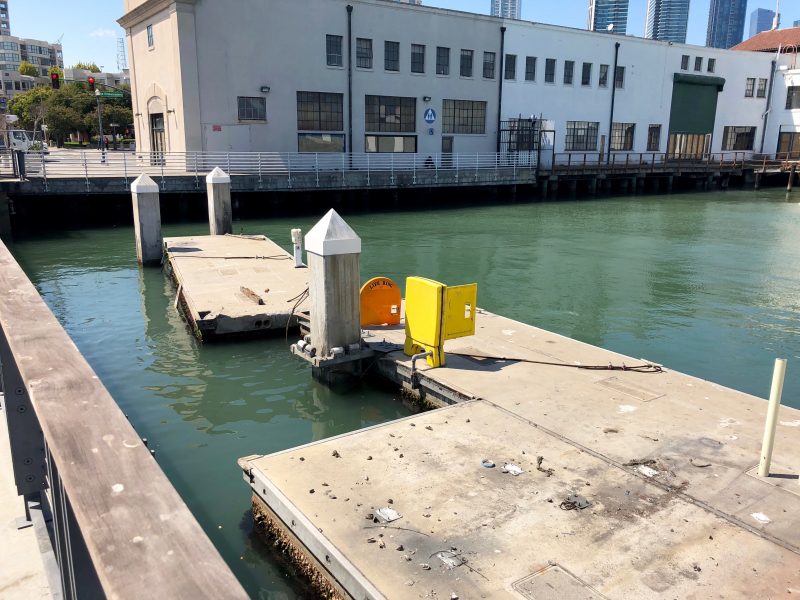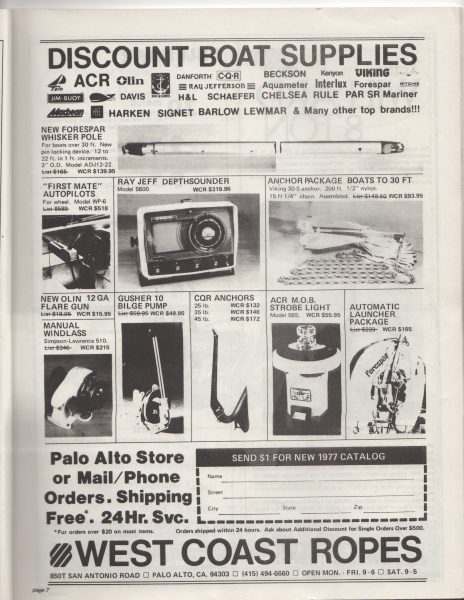
Misfortune, Murder or Manslaughter?
Back in September, we noted the strange case of Lewis Bennett, his wife of just three months, Isabella Hellman, and their honeymoon-gone-wrong aboard their 37-ft catamaran. The couple were on the way back to Florida on the final leg of a two-week Caribbean cruise in the spring of 2017, when, according to Bennett, he was awoken around midnight by the sound and feel of the boat hitting something.

The last time Bennett had seen his wife on their cat, Surf Into Summer, was at the helm about 8 p.m. the evening before. But when he ran topside, there was no sign of her — and the boat was sinking. Bennett, 41, eventually set off an EPIRB and climbed into the boat’s liferaft with a few belongings. He was rescued by the Coast Guard a few hours later. A four-day search turned up no trace of Hellman, a 40-year-old real-estate agent from Delray Beach, Florida.
During that search, the Coasties did find the half-sunk Surf Into Summer, which they dove on and photographed. There was no damage on either hull that indicated a collision with anything above or below the water. There were, however, indications that “holes had been made from the inside.” A beacon was put aboard but later stopped transmitting, suggesting the boat probably sank.
As if all that weren’t weird enough, among the items Bennett had in the liferaft was a stash of coins that it turned out he’d stolen from a charter boat in St. Maarten. He was put in jail in Florida for that offense. While he was there, the FBI worked the case and eventually charged him with the murder of his wife, citing insurance money and property she owned in Florida among the motives.
Bennett was due to go to trial for second degree murder in December. But on Monday, he pleaded guilty to involuntary manslaughter for basically doing nothing to look for his wife — not turning the boat around, not shining a light, nothing. He doesn’t even remember calling her name. Bennett also admitted that her loss was foreseeable and caused by his negligence.
The plea, which carries a sentence of no less than seven years, is quite a step down from the original charge of second degree murder, which carries a maximum sentence of life in prison.
Bennett, a mining engineer who holds dual citizenship in Australia and the UK, will be sentenced in January. Hellman’s family is proceeding with a civil suit to prevent him from getting any of his wife’s assets.
We will have a more detailed version of this story in an upcoming issue of Latitude.
Carnage Mounts in Route du Rhum
This 11th edition of the Route du Rhum solo transatlantic race has been a challenging one for the competitors and their boats. Autumn has set in across western Europe and the North Atlantic ocean, and the weather pattern has been one depression after another. With gale-force winds and the accompanying sea state followed by light-air zones with even more chaotic seas, keeping boats in one piece and making good progress has been extremely challenging. After just over three days of racing, the majority of the Ultime trimarans have sustained damage. In the IMOCA 60 monohull division, just 11 of the original 20 starters remain on course and racing as of this writing.
Ultime Trimarans
When the race started on Sunday, all eyes were on the Ultime division of maxi-trimarans. One by one, however, the competitors have fallen by the wayside, leaving a two-boat maxi-trimaran match race. After getting off to a cracking start, Seb Josse’s new full-foiling trimaran Gitana 17 ripped the bow off her starboard float and retired to Spain.

Less than a day later, current Vendée Globe champion Armel le Cléac’h capsized when one of the hulls on his new foiling boat broke off at the crossbeam. Le Cléac’h has been safely rescued by a fishing boat; his team is organizing a rescue for the boat. His brand-new trimaran Banque Populaire IX has now capsized twice this year, leading one to wonder if this may be the end of the boat. Currently, François Gabart on MACIF is maintaining a narrow lead over Francis Joyon on IDEC Sport, though we suspect François will light the afterburners once the duo reaches the trades.
IMOCA 60s
The IMOCA 60 division saw a record 20 entries, and right off the bat Briton Alex Thomson on Hugo Boss made a gutsy navigational move and split from the fleet to assume an early lead. Flush with boat speed, the perennial Vendée Globe competitor and 24-hour IMOCA distance record holder has continued to build a cushion over his main rivals, though Alex may see much of his 80-mile lead evaporate when he crosses the next ridge of high pressure before reaching the trades. Behind him, the young sailor Paul Meilhat onboard SMA is sailing incredibly well to remain in second place on what is likely the fleet’s quickest boat to be fitted with conventional straight daggerboards. Vincent Riou on PRB, Yann Elies on Ucar – Saint Michel and Boris Hermann on Malizia 2 round out the top five.

Class 40s
The record-setting 53-boat Class 40 division has handled the challenging conditions better than most fleets. Nevertheless, third-place British sailor Sam Goodchild has dismasted after a phenomenal start. Fellow countryman Phil Sharp on Imerys Clean Energy has assumed third place. Sharp’s own challenges include a blown fractional spinnaker halyard that required two trips aloft and a blown water-ballast tank. Pre-race favorite Yoann Richomme has a scant lead over Aymeric Chappellier and Sharp.

Boats not near the front of the pack will continue dealing with low-pressure system after low-pressure system. Meanwhile, ports all over western Europe — particularly in Northern Spain — are filling up with boats whose skippers are licking their wounds and contemplating whether to retire or resume racing after repairs. As a result of the brutal conditions, the race committee has already extended the finish deadline by five days with the possibility of more.
Ad: Modern Sailing School & Club
Embarcadero Seawall Will Get a Facelift
A bond measure passed yesterday that will put over $400 million into repairing the Embarcadero seawall in San Francisco. The century-old wall is in severe need of repairs, but is also being buttressed in preparation for climate change.

The Embarcadero seawall, which is over 100 years old, is in “desperate need of repair,” according to the Port of San Francisco. The seawall is also in need of upgrades to bolster it against earthquakes and rising sea levels. “Today, king tides flood the Embarcadero Promenade,” the Port said.
Proposition A passed yesterday with 82% support, according to the San Francisco Chronicle.
“The Seawall supports key utility and transportation infrastructure including the BART, Muni, and ferry transportation networks. It also supports critical emergency response and recovery areas on the Embarcadero and provides flood protection for downtown San Francisco,” the Port said, adding that the Embarcadero represents “over $100 billion in economic activity and assets along the waterfront.”
Many local sailors know that in general, the Bay Area’s boating infrastructure is in an abominable state. While not directly tied to Proposition A or the Embarcadero seawall, we thought this was a good chance for us to complain about the state of affairs along one of the world’s wealthiest waterfronts.

We often hear stories of gleaming, awe-inspiring docks and facilities in Washington State, New England, Europe and other destinations. It is simply beyond comprehension to us that with all the wealth being accumulated just a few blocks from the Bay, how is it that San Francisco and surrounding waterfronts don’t get a little of those trickle-down funds to repair, replace and rebuild their boating infrastructure?

If you have any thoughts — or even better, complaints — on this, we’d like to hear. (With our new website, you can also comment on this story below.)
In other maritime-midterm news
We came across this charming story from BuzzFeed: “Area dad and former BuzzFeed News reporter McKay Coppins thought his 5-year-old daughter Ellie was upset when she didn’t get to go voting with her parents on Tuesday. So Coppins took her back to the polling station and explained the wonders of democracy to her. Turns out, Ellie wanted to go boating, not voting.”
Change of Course at West Marine
West Marine issued a brief statement on Tuesday saying CEO Doug Robinson has left the company after less than a year in the post. Encouragingly, Robinson was already an active sailor when he joined West Marine in January. He had previously worked for Lowe’s for 13 years in several executive roles.
During his brief tenure, Robinson had initiated renewed activity in the sailing market with event sponsorships and more engagement on the local level. West Marine was founded in the Bay Area’s Sunnyvale in 1968, and went on to become the largest marine retailer in the world. Along the way, they opened stores in Palo Alto, Oakland and Sausalito, and began advertising with Latitude 38 in our very first issue in April 1977. The company went public in 1993, and was bought by the private equity firm Monomoy Capital Partners in summer 2017.

West has been the major player in the sailing market almost since it opened, but, despite a more robust economy, it hasn’t all been smooth sailing. The company recently consolidated its Oakland and Alameda stores into one facility in the mall on the South Shore Center in Alameda. The West Marine in Pleasant Hill also recently closed.

“An executive search is underway for a new CEO,” said Tuesday’s statement. “We anticipate significant interest from seasoned executives with extensive retail and e-commerce operational experience. The senior leadership team at West Marine remains in place and focused on returning the company to its core business and serving local boating communities.”

If you were thinking of looking for a job at West Marine, we know there’s an opening at HQ in Watsonville. Retail remains a challenging business, and West Marine is looking for a new navigator to chart the course.

